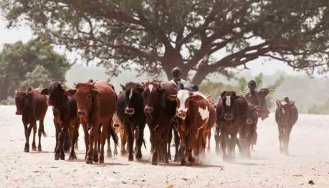News & Updates
Early interventions prevented a humanitarian emergency in the Horn of Africa in 2017
27 July 2018

A new report from the UN Food and Agriculture Organisation (FAO) has revealed that early interventions in countries predicted to be effected by natural disasters can prevent these threats from escalating into humanitarian emergencies and mitigate their impacts.
The ‘Impact of Early Warning Early Action’ report looks at protecting pastoralist livelihoods ahead of drought in the Horn of Africa, specifically Ethiopia, Kenya and Somalia.
The report found that for every $1 the FAO spent on early livestock interventions, as pastoralists braced prepared for a harsh drought, families saw benefits of up to $9 due to less animals dying due to hungerand disease, and producing up to three times more milk.
The early interventions also helped farmers safe guard their livelihood as many rely on their animals for economic security. When farmers are forced to sell their animals in order to buy food it is a concerning indicator of severe hunger that can create a spiral of poverty and aid dependence.
In recent years, the weather in the Horn of Africa has become increasingly unpredictable with frequent drought leaving communities vulnerable. On a global scale, natural disasters now strike almost five times more than they did forty years ago.
Dominique Burgeon, Director of FAO’s Emergency and Rehabilitation Division, Strategic Programme on Resilience commented:
“Investing in early interventions is not only humane and smart, it is also cost effective. Protecting livelihoods before disasters strike means greater resilience to future shocks, and less pressure on strained humanitarian resource”
“Acting early is crucial and possible, and it is also the responsible thing to do. There is mounting evidence that the earlier we respond, the greater the capacity of communities to cope”
The report indicates how significant early interventions can be in preventing a large humanitarian crisis. In 2017 when rains failed the FAO responded quickly to assist thousands of vulnerable herders.
The interventions focused on distributing high nutrient emergency feed for breeding animals, providing veterinary services, rehabilitating water points, installing water points and delivering training on livestock best practices.
Consequently, in Kenya, an over of two more animals were saved per family compared to those who did not receive assistance and every child in the programme drank half a litre more milk each day, this equates to 25% of the calories and 65% of the protein a five year old should have each day.
During the drought’s peak the herds assisted by FAO were producing three times their usual amount of milk.
Kenyan farmers who did not receive early assistance were forced to sell twice as many of their animals as prices fell significantly from $80 to $30. They also killed almost triple the amount of animals, to eat and to lessen the burden of feeding them.
In Kenya, for every $1 the FAO spent on livestock interventions, each family received a return of $3.5, this rose to $9 when the cost of food assistance and restocking are added.
In Somalia, veterinary treatment for a goat costs $0.40 and $40 to purchase a new one. The FAO saved over $40 million by treating over 1 million animals belonging to 180,000 people in the worst hit areas of the county. The milk from these animals provided nourishment to 80,000 mothers and children.
The FAO assisted 7 million Somalis in total and helped launch a large scale famine prevention programme.
In Ethiopia, for every $1 FAO invested in the protection of animals, each family gained $7 in benefits.
The report indicates the effectiveness and economic sustainability of early intervention programmes in averting famine in supporting vulnerable pastoralists.
If you’d like to stay informed on the latest updates in aid and development, please sign up for the AIDF newsletter.
Image credit: FAO